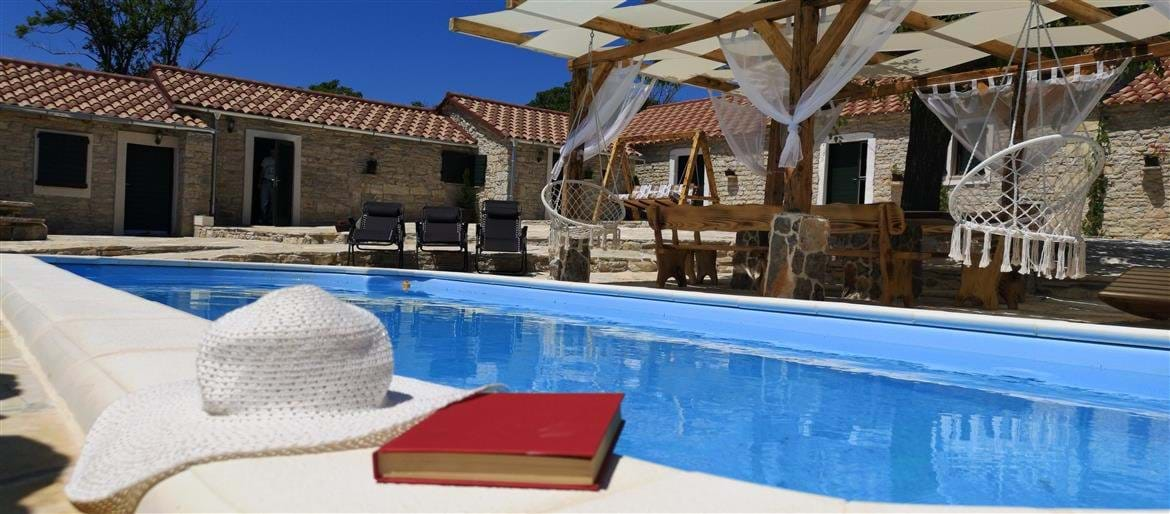Local Area Information
Juniper stone cottage is located in a little village next to the town Benkovac, which is located where the plain of Ravni Kotari and the karstic plateau of Bukovica meet, 20 km from the town of Biograd na Moru and 30 km from Zadar. The Zagreb-Split motorway and Zadar-Knin railway pass through the town. One of the most famous attractions in Benkovac is the monthly fair, taking part on every 10th of the month. The town of Benkovac has a rich cultural and historical heritage, and is situated beneath a medieval fort. The Nature park Vransko jezero, which is also the largest lake in Croatia, is located nearby.
Only 10 km away the Adriatic waves penetrated the Dalmatian karst and created the smallest sea in the world, the Karin Sea, as well as the greatest wealth of the place of the same name. Its beauty is adorned by its watercourses, the river Bijela and the river Karisnica, which create healing mud through freshwater tributaries. It is extremely effective in alleviating problems caused by rheumatic and similar diseases.
Nothern Croatia boasts quaint Italianate cities and epic national parks, heaps of culture and fab local cuisines. A few beaches fringe its coastline, and unspoilt islands encircle its shore.
Krka National Park
This majestic national park's centrepiece is the Krka River. Its 73 kilometres are lined with gushing, glittering waterfalls. The land surrounding it is an intensely well-nourished green, and the variety of dazzling wild flowers is matched only by that of the birds. You can swim, white-water raft, or just listen to golden eagles squawking overhead as you gaze at the view.
Paklenica National Park
An especially dramatic national park, the Paklenic Karst river canyon sits at the southern slopes of the Velebit Mountain near Zadar. It has two spectacular canyons, Mala (small) Paklenic and Velika (large) Paklenic. Standing at a rocky peak and looking out into the vast abyss is breath-taking. The park is crawling with rock-climbers because of its sheer stone cliffs, but the central part is largely covered in dense forest. Make sure to venture into the icicle-lined cave of Manita Peć, the only one open to the public.
Zadar
This coastal city is famed for its crumbling, intricate architecture. The old town is an antiquated patchwork of Roman and Venetian ruins, with churches dating from the 8th, 9th and 11th centuries and a soaring 12th-century cathedral. Go to the beach to listen to the ethereal song of the sea organ as you watch the solar-powered 'Sun Salutation' light display.
Kornati archipelago
These islands are dry little deserts dotted across the sea, just to the west of Murter. Some are alabaster-white and some are tawny-brown, but there’s little green to be found – their once heaving forestry was burnt down to make pasture for sheep, but they no longer live there either, and most Kornati people live in Murter. It’s fascinating to stroll across these barren lands, which also happen to be perfect for scuba-diving.
Pag
With its stretches of dry landscape set against the rich blue of the Adriatic, its two mountain ridges and a scattering of villages, Pag has a distinctively dramatic look. It’s worth going just for the food: meat and milk are extra flavoursome because of the sheep's herbaceous diet, and the island speciality is paški sir, a tangy olive-oil doused cheese, aged in stone. Try the rich stuff with a class of expertly produced local wine.
Zrce Beach
The rest of the island may have a delicious, crumbling-around-the-edges vibe that makes 2016 seem lightyears in the future, but its unlikely centrepiece is party hotspot Zrće beach. Each summer, when Hideout and other festivals wash ashore, it throbs with hedonistic energy late into the nights.
If you fancy visiting any of the nearby places and you haven't got your own transport, make sure you contact your host in advance for any necessary arrangements to be put in place for you. Of if you need any other information about the local area just email us with the details of your enquiry.
